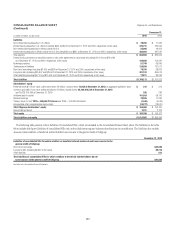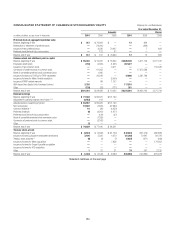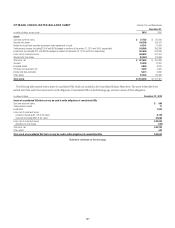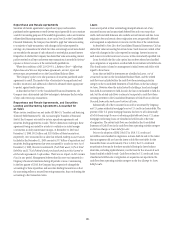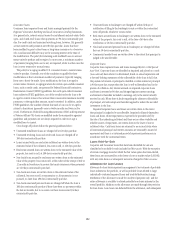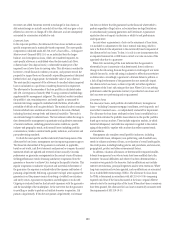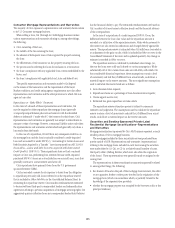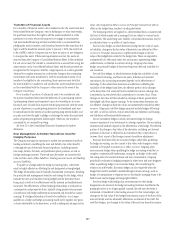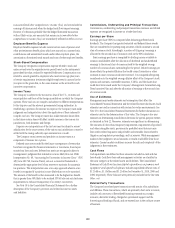Citibank 2010 Annual Report Download - page 163
Download and view the complete annual report
Please find page 163 of the 2010 Citibank annual report below. You can navigate through the pages in the report by either clicking on the pages listed below, or by using the keyword search tool below to find specific information within the annual report.161
Repurchase and Resale Agreements
Securities sold under agreements to repurchase (repos) and securities
purchased under agreements to resell (reverse repos) generally do not constitute
a sale for accounting purposes of the underlying securities, and so are treated as
collateralized financing transactions. As set out in Note 26 to the Consolidated
Financial Statements, the Company has elected to apply fair value accounting
to a majority of such transactions, with changes in fair value reported in
earnings. Any transactions for which fair value accounting has not been elected
are recorded at the amount of cash advanced or received plus accrued interest.
Irrespective of whether the Company has elected fair value accounting, interest
paid or received on all repo and reverse repo transactions is recorded in Interest
expense or Interest revenue at the contractually specified rate.
Where the conditions of ASC 210-20-45-11, Balance Sheet—Offsetting:
Repurchase and Reverse Repurchase Agreements, are met, repos and
reverse repos are presented net on the Consolidated Balance Sheet.
The Company’s policy is to take possession of securities purchased under
agreements to resell. The market value of securities to be repurchased and
resold is monitored, and additional collateral is obtained where appropriate
to protect against credit exposure.
As described in Note 25 to the Consolidated Financial Statements, the
Company uses a discounted cash flow technique to determine the fair value
of repo and reverse repo transactions.
Repurchase and Resale Agreements, and Securities
Lending and Borrowing Agreements Accounted for
as Sales
Where certain conditions are met under ASC 860-10, Transfers and Servicing
(formerly FASB Statement No. 166, Accounting for Transfers of Financial
Assets), the Company accounts for certain repurchase agreements and
securities lending agreements as sales. The key distinction resulting in these
agreements being accounted for as sales is a reduction in initial margin
or restriction in daily maintenance margin. At December 31, 2010 and
December 31, 2009, $0.2 billion and $13.0 billion of these transactions,
respectively, were accounted for as sales that reduced trading account assets.
Included in the December 31, 2009 amount is $5.7 billion of repurchase and
securities lending agreements that were accounted for as sales in error. As of
December 31, 2009, this error constituted 0.3% of Total assets, 0.3% of Total
liabilities and 3.7% of Federal funds purchased and securities loaned or
sold under agreements to repurchase. There was no impact on Net income
(loss) in any period. Management believes that this error was immaterial to
Citigroup’s financial statements during all periods at issue. Commencing
in the first quarter of 2010, the Company has prospectively changed the
accounting for these repurchase and securities lending transactions so that
the accounting reflects a secured borrowing transaction, thus conforming the
accounting to the transaction terms.
Loans
Loans are reported at their outstanding principal balances net of any
unearned income and unamortized deferred fees and costs except that
credit card receivable balances also include accrued interest and fees. Loan
origination fees and certain direct origination costs are generally deferred
and recognized as adjustments to income over the lives of the related loans.
As described in Note 26 to the Consolidated Financial Statements, Citi has
elected fair value accounting for certain loans. Such loans are carried at fair
value with changes in fair value reported in earnings. Interest income on
such loans is recorded in Interest revenue at the contractually specified rate.
Loans for which the fair value option has not been elected are classified
upon origination or acquisition as either held-for-investment or held-for-sale.
This classification is based on management’s initial intent and ability with
regard to those loans.
Loans that are held-for-investment are classified as Loans, net of
unearned income on the Consolidated Balance Sheet, and the related
cash flows are included within the cash flows from investing activities
category in the Consolidated Statement of Cash Flows on the line Change
in loans. However, when the initial intent for holding a loan has changed
from held-for-investment to held-for-sale, the loan is reclassified to held-for-
sale, but the related cash flows continue to be reported in cash flows from
investing activities in the Consolidated Statement of Cash Flows on the line
Proceeds from sales and securitizations of loans.
Substantially all of the Consumer loans sold or securitized by Citigroup
are U.S. prime residential mortgage loans or U.S. credit card receivables. The
practice of the U.S. prime mortgage business has been to sell substantially
all of its loans except for non-conforming adjustable rate loans. U.S. prime
mortgage conforming loans are classified as held-for-sale at the time
of origination. The related cash flows are classified in the Consolidated
Statement of Cash Flows in the cash flows from operating activities category
on the line Change in loans held-for-sale.
Prior to the adoption of SFAS 166/167 in 2010, U.S. credit card
receivables were classified at origination as loans-held-for-sale to the extent
that management did not have the intent to hold the receivables for the
foreseeable future or until maturity. Prior to 2010, the U.S. credit card
securitization forecast for the three months following the latest balance
sheet date, excluding replenishments, was the basis for the amount of such
loans classified as held-for-sale. Cash flows related to U.S. credit card loans
classified as held-for-sale at origination or acquisition are reported in the
cash flows from operating activities category on the line Change in loans
held-for-sale.




